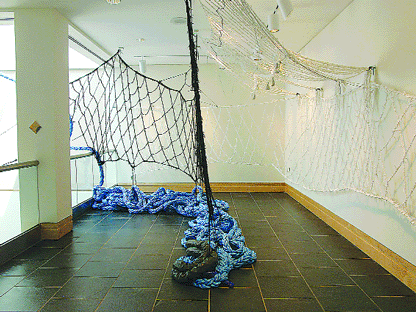Artist installation pays tribute to family members who paved the way across the Hudson
Remembering Augie and Eleanor Nigro
He dug the earth:
She ferried the river.
Both sought passage beyond the Hudson
In order to survive
The depression,
erecting
subway props
and swearing
the slipper shop.
They strove
to connect
west with east,
New world with old,
Through the kinship
Of family;
Such was the fabric
of their lives.
Such is the power
Of tunnel vision.
August Nigro
These words were written for Shelia Pepe’s installation at the Jersey City Museum by her cousin Dr. August Nigro. They capture the sense of time, place, and purpose of this installation dedicated to her maternal aunt and uncle––Eleanor D’Amato Nigro and Augustine Nigro––and all the workers that built and used the trans-Hudson tunnels to go to work in the first half of the 20th century.
A web of crocheted shoelaces and heavy coiled blue towline hang and weave together a tunnel and passage leading to the atrium of the museum. The bright blue line drapes and hangs like a curtain pull and ends in the middle of the open space, creating a sense of an incompletion, of the unknown, which surrounds us with a physiological wanting. Will we ever get to the other side?
From a distance, the crocheted shoelaces appear as physical manifestations of a Brice Marden painting. But with a closer inspection she destroys any similarity with generous multiplicity and the layering of meaning and function generating a sense of soul for each shoelace. This lifts Pepe’s installation out of the trap of formal language and beyond modernism’s impenetrable web of self-reference.
At first glance, her structure looked spindly and frail like a macramé wall hanging wanting to be on a much larger scale. It wasn’t until I was standing inside the structure that I felt the emotional strength of this piece. By evoking a human vulnerability in the fear of crossing the unknown and a soul for the handmade, Pepe, a Gay City News contributor, has successfully anthropomorphized architecture in the loaded memory of her concept.
Craft has always been considered on the edge of greatness and tied to “woman’s work,” but with Pepe’s knowledge of history, the symbolic power of materials, formal vitality, and her own identity and place in the world, she easily topples this hierarchy and creates a truly moving installation without falling into sentimentality or angry rebellion. She conveys a potent but subtle political subtext that we need to look at right now. The simplicity of her color palette––white, black, silver, and blue––assist the organic transformation of her grid, helping to drive the power of her work and to sharpen our experiential vision that connects our somatic self to the poetry inside us.
The artist will host a public reception from 7-8:30 p.m. on Thursday, September 1.
gaycitynews.com



































